Many people know someone with an artificial knee or hip joint. Shoulder replacement is less common. But it is just as successful in relieving joint pain. Shoulder replacement surgery started in the 1950s. It was used as a treatment for severe shoulder fractures. Over the years, this surgery has come to be used for many other painful conditions of the shoulder. These include:
- Osteoarthritis (degenerative joint disease)
- Rheumatoid arthritis
- Post-traumatic arthritis
- Rotator cuff tear arthropathy (a combination of severe arthritis and a massive non-reparable rotator cuff tendon tear)
- Avascular necrosis (osteonecrosis)
- Failed previous shoulder replacement surgery
- Severe fractures
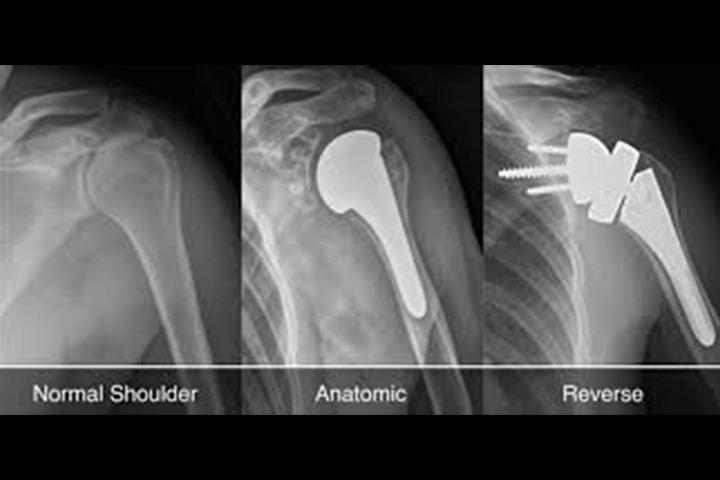
The shoulder is a ball-and-socket joint that enables you to raise, twist, and bend your arm. It also lets you move your arm forward, to the side, and behind you. In a normal shoulder, the rounded end of the upper arm bone (head of the humerus) glides against the small dish-like socket (glenoid) in the shoulder blade (scapula). These joint surfaces are normally covered with smooth cartilage. They allow the shoulder to rotate through a greater range of motion than any other joint in the body.
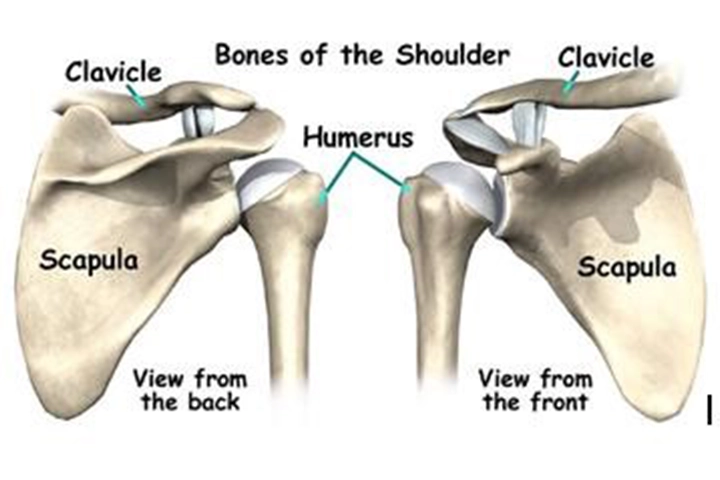
The surrounding muscles and tendons provide stability and support. Unfortunately, conditions like those listed above can lead to loss of the cartilage and mechanical deterioration of the shoulder joint. The result can be pain. You can have a stiff shoulder that grinds or clunks. This can lead to a loss of strength, decreased range of motion in the shoulder, and impaired function. X-rays of the shoulder would show:
- Loss of the normal cartilage joint space
- Flattening or irregularity in the shape of the bone
- Bone spurs
- Loose pieces of bone and cartilage floating inside the joint
In severe cases, bone-on-bone arthritis may lead to erosion--wearing away of the bone.
- Osteoarthritis has become a common reason for Shoulder Joint Replacement
- Severe Four-part fracture
- Cuff Tear Arthropathy
- Avascular Necrosis
- Deep Sea Diving
Treatment of an arthritic shoulder starts with rest, exercise, and taking arthritis medications. Resting the shoulder and applying moist heat can ease mild pain. After strenuous activity, an ice pack may be more effective at decreasing pain and swelling.
Physical therapy may be helpful when arthritis is in its early stages. It helps maintain joint motion and strengthen the shoulder muscles. Physical therapy is less effective when the arthritis has advanced to the point that bone rubs on the bone. When this is the case, physical therapy may make the shoulder hurt more.
Arthritis medications, called nonsteroidal anti-inflammatories (NSAIDs), can control arthritis pain. Periodic steroid injections, Viscosupplementations, and Growth Factor Concentrate (GFC) into the shoulder joint can provide temporary pain relief. Excessive cortisone shots can have adverse effects.
Shoulder joint replacement
Shoulder Joint Replacement becomes the only treatment option when there is no relief of pain due to conditions mentioned in the indications.
There are several different types of shoulder replacements. The usual total shoulder replacement involves replacing the arthritic joint surfaces with a highly polished metal ball attached to a stem, and a plastic socket.
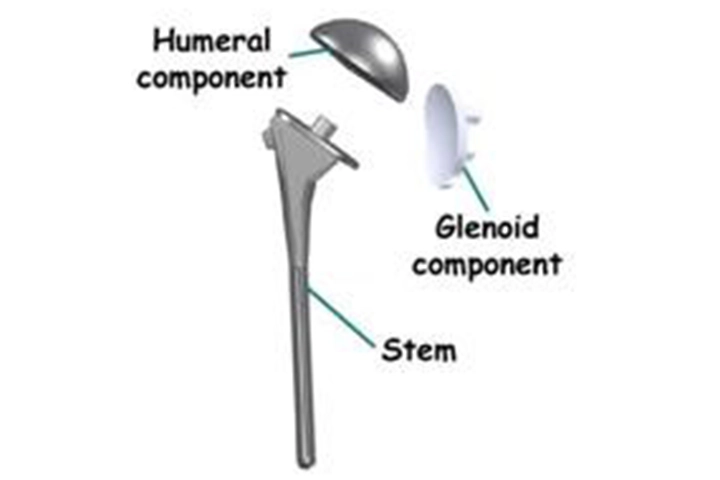
The components come in various sizes. If the bone is of good quality, we will choose to use a non-cemented or press-fit humeral component. If the bone is soft, the humeral component may be implanted with bone cement. In most cases, an all-plastic glenoid component is implanted with bone cement. Implantation of a glenoid component is not advised if:
- The glenoid has good cartilage.
- The glenoid bone is severely deficient.
- The rotator cuff tendons are irreparably torn.
Patients with bone-on-bone osteoarthritis and intact rotator cuff tendons are generally good candidates for conventional total shoulder replacement.
Depending on the condition of the shoulder, we may replace only the ball. Sometimes, this decision is made in the operating room at the time of the surgery.
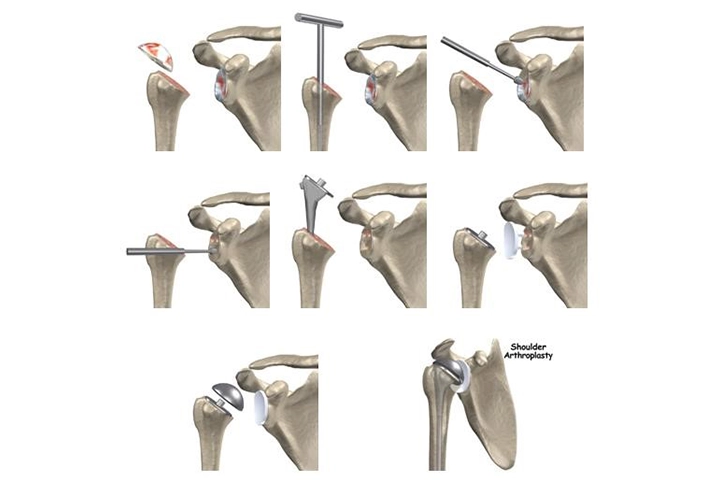

The more recent type of shoulder replacement is called reverse total shoulder replacement. Reverse total shoulder replacement is used for people who have:
- Completely torn rotator cuffs and
- The effects of severe arthritis (cuff tear arthropathy) or
- Had a previous shoulder replacement that failed
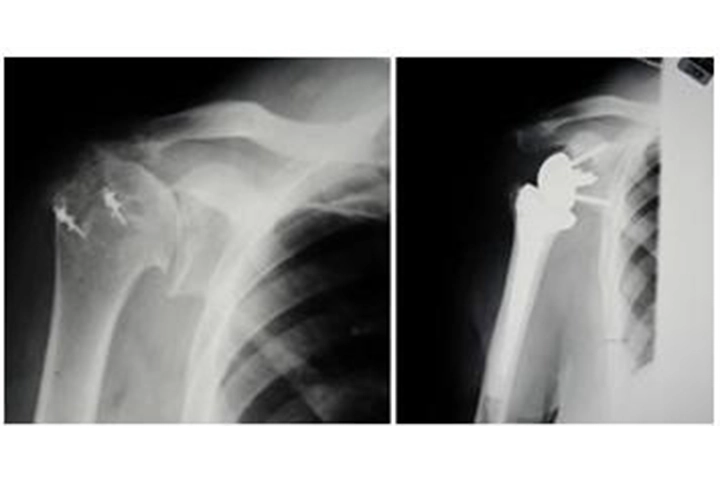
X-rays before and after reverse total shoulder replacement for cuff tear arthropathy
Shoulder replacement surgery is highly technical. It should be performed by a surgical team with experience in this procedure. Each case is individual. We will evaluate your situation carefully before making any decisions. Do not hesitate to ask what type of implant will be used in your situation. Ask why that choice is right for you.
At CSI, we have a team of Orthopaedic Surgeons who do a thorough examination and diagnosis of your condition. Our Anesthetists do a pre-surgical medical evaluation and the cardiac patients undergo ECHO before the surgery at the center. The Anesthetists would ask you to stop certain medications like blood thinners before the surgery.
The surgery is performed on an inpatient basis. Most patients are discharged from the hospital on the second or third day after the operation.
A careful, well-planned individualized rehabilitation program is critical to the success of a shoulder replacement. You usually start gentle physical therapy on the first day after the operation. You wear an arm sling during the day for the first several weeks after surgery. Most patients can perform simple activities such as eating, dressing, and grooming within 2 weeks after surgery. Driving a car is not allowed for 6 weeks after surgery.
Here are some "do's and don'ts" for when you return home:
- Don't use the arm to push yourself up in bed or from a chair because this requires forceful contraction of muscles.
- Do follow the program of home exercises prescribed for you. You may need to do the exercises 4 to 5 times a day for a month or more.
- Don't overdo it! If your shoulder pain was severe before the surgery, the experience of pain-free motion may lull you into thinking that you can do more than is prescribed. Early overuse of the shoulder may result in severe limitations in motion.
- Don't lift anything heavier than a glass of water for the first 6 weeks after surgery.
- Do ask for assistance. Your physician may be able to recommend an agency or facility if you do not have home support.
- Don't participate in contact sports or do any repetitive heavy lifting after your shoulder replacement.
- Do avoid placing your arm in any extreme position, such as straight out to the side or behind your body for the first 6 weeks after surgery.
Many thousands of patients have experienced an improved quality of life after shoulder joint replacement surgery. They experience less pain, improved motion and strength, and better function.
If you would like to inquire about the Shoulder Replacement Procedure, you can fill out the inquiry form below or call us at 011-4122 3333.

